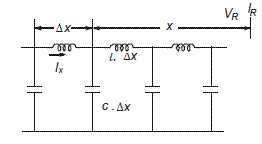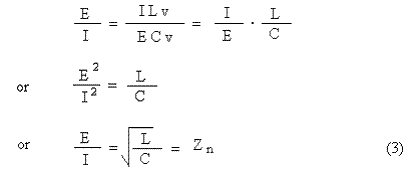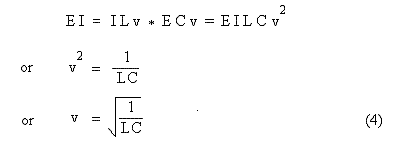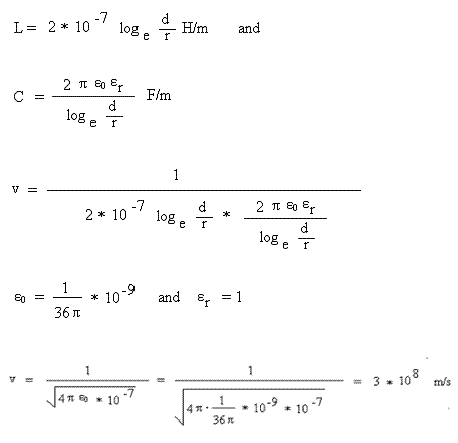- This topic has 2 replies, 1 voice, and was last updated 2 years, 11 months ago by .
-
Topic
-
When they close the circuit breaker at the substation at an instant t=0, how long will it take for the power to reach the load terminal located at 1000 Km?
When they close the circuit breaker at the substation at an instant t=0, how long will it take for the power to reach the load terminal located at 1000 Km?
Viewing 2 replies - 1 through 2 (of 2 total)
Viewing 2 replies - 1 through 2 (of 2 total)
- You must be logged in to reply to this topic.

 So we have E = I L (dx/dt) = I L v (1) where v is the velocity of propagation of wave. The current I carries a charge Idt in the time dt, and this charge remains on the line to charge it up to the potential of E. Since the capacitance of length dx of the line is Cdx (C is the capacitance of the line per unit length), its charge is ECdx, so we have I dt = E C dx I = E C (dx/dt) = E C v (2) The switching of an emf E on to the line results therefore in a wave of current I and velocity v where E and I are given by equations (1) and (2). Dividing equation (1) by equation (2), we have
So we have E = I L (dx/dt) = I L v (1) where v is the velocity of propagation of wave. The current I carries a charge Idt in the time dt, and this charge remains on the line to charge it up to the potential of E. Since the capacitance of length dx of the line is Cdx (C is the capacitance of the line per unit length), its charge is ECdx, so we have I dt = E C dx I = E C (dx/dt) = E C v (2) The switching of an emf E on to the line results therefore in a wave of current I and velocity v where E and I are given by equations (1) and (2). Dividing equation (1) by equation (2), we have  The expression is a ratio of voltage and current which has the dimensions of impedance and is therefore here designated as surge impedance of the line. It is also called the natural impedance because this impedance has nothing to do with the load impedance, but depends only on the line constants. The value of this impedance is 400 ? to 600 ? for an overhead line and 40 ? to 60 ? for a cable. Multiplying equations (1) and (2), we have
The expression is a ratio of voltage and current which has the dimensions of impedance and is therefore here designated as surge impedance of the line. It is also called the natural impedance because this impedance has nothing to do with the load impedance, but depends only on the line constants. The value of this impedance is 400 ? to 600 ? for an overhead line and 40 ? to 60 ? for a cable. Multiplying equations (1) and (2), we have  Substituting the values of L and C for overhead lines in above expression, we have
Substituting the values of L and C for overhead lines in above expression, we have  Since the product of L and C is the same for all overhead lines, it follows that the velocity of propagation is also the same. This velocity is the same as the velocity of light, but as we have assumed a resistance less line in the above analysis, the velocity in practice will be from 5 to 10 percent less than this. Normally a velocity of approximately 285 m/?s is assumed. The velocity of propagation over the cables will be smaller than that over the overhead lines because in case of overhead lines ? r = 1 while for cables ? r > 1, being the dielectric constant. The velocity of wave propagation in case of cables can be given as
Since the product of L and C is the same for all overhead lines, it follows that the velocity of propagation is also the same. This velocity is the same as the velocity of light, but as we have assumed a resistance less line in the above analysis, the velocity in practice will be from 5 to 10 percent less than this. Normally a velocity of approximately 285 m/?s is assumed. The velocity of propagation over the cables will be smaller than that over the overhead lines because in case of overhead lines ? r = 1 while for cables ? r > 1, being the dielectric constant. The velocity of wave propagation in case of cables can be given as  where ? r varies from 2.5 to 4 in case of cables. As you see the equation of voltage and current propagation velocity can prove v =1/?LC easily, but I am not sure about electrical power velocity concepts. It seems the electrical power wave ( E I ) is a mathematical existence, indeed in physical point the voltage (referring to electrical field) of a transmission line is related to wave current which propagate through line inductance with v velocity (E=ILdx/dt=ILv) and the current of transmission line (referring to magnetic field) is related to wave voltage that propagate through line capacitance with v velocity (I= ECdx/dt=ECv). Indeed it is same electromagnetic wave propagation concept.
where ? r varies from 2.5 to 4 in case of cables. As you see the equation of voltage and current propagation velocity can prove v =1/?LC easily, but I am not sure about electrical power velocity concepts. It seems the electrical power wave ( E I ) is a mathematical existence, indeed in physical point the voltage (referring to electrical field) of a transmission line is related to wave current which propagate through line inductance with v velocity (E=ILdx/dt=ILv) and the current of transmission line (referring to magnetic field) is related to wave voltage that propagate through line capacitance with v velocity (I= ECdx/dt=ECv). Indeed it is same electromagnetic wave propagation concept.